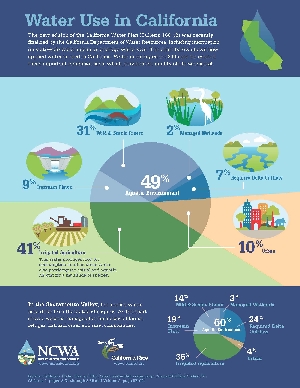Link: Web Link
"One of the unfortunate byproducts of the current drought are the myths circulating regarding water use and the means for addressing the water crisis in the state. Some are perpetuations of myths developed during past water crises. Others build upon misinformation that has a more recent origin. Below are four myths that you may see in media accounts of the drought.
1) Agriculture uses 80 percent of water in the state.
According to the 2013 California Water Plan, in an average water year, agriculture uses 41 percent of the applied water in California (California Water Plan 2013, Volume 1, page 3-35). Urban water uses total 10 percent and various environmental uses total 49 percent of applied water in the state.
2) Unlike urban water users who have just received a mandatory 25% reduction in water use, agricultural water users have not had their water supplies cut.
Last year, while those of us living in urban areas were tasked with voluntarily reducing water use, agricultural water users were suffering devastating cutbacks in supplies, many receiving no water or up to 5 percent of their contracted amounts. This year, even the most senior agricultural water rights holders in the state will be cut back at least 25 percent. Most will be cut back much more than that, if they get any water at all.
3) The water rights in the state are over-appropriated.
Over the past several years, there have been claims that California’s water system is overappropriated by five times and is therefore somehow broken. This statement mischaracterizes the California water rights system and ignores the fundamental and sophisticated way water is managed in the state.
Those claiming that the water rights are overappropriated have taken all of the water rights maintained by the State Water Resources Control Board (SWRCB), added them up, and declared that the state’s water rights total more than the available water and thus the state is overappropriated. What this ignores are the considerable non-consumptive water rights, the substantial water reuse and recoverable losses in the state’s water system and the restrictions on water rights.
4) New surface water storage would not help during a drought year.
Importantly, if Sites reservoir was in operation today, total north of Delta storage this year would have increased by 900,000 acre-feet, including an additional 280,000 acre-feet in Shasta reservoir. This additional water could be used for multiple purposes: fish, farms, birds, cities, recreation and to help maintain salinity levels in the Delta."

